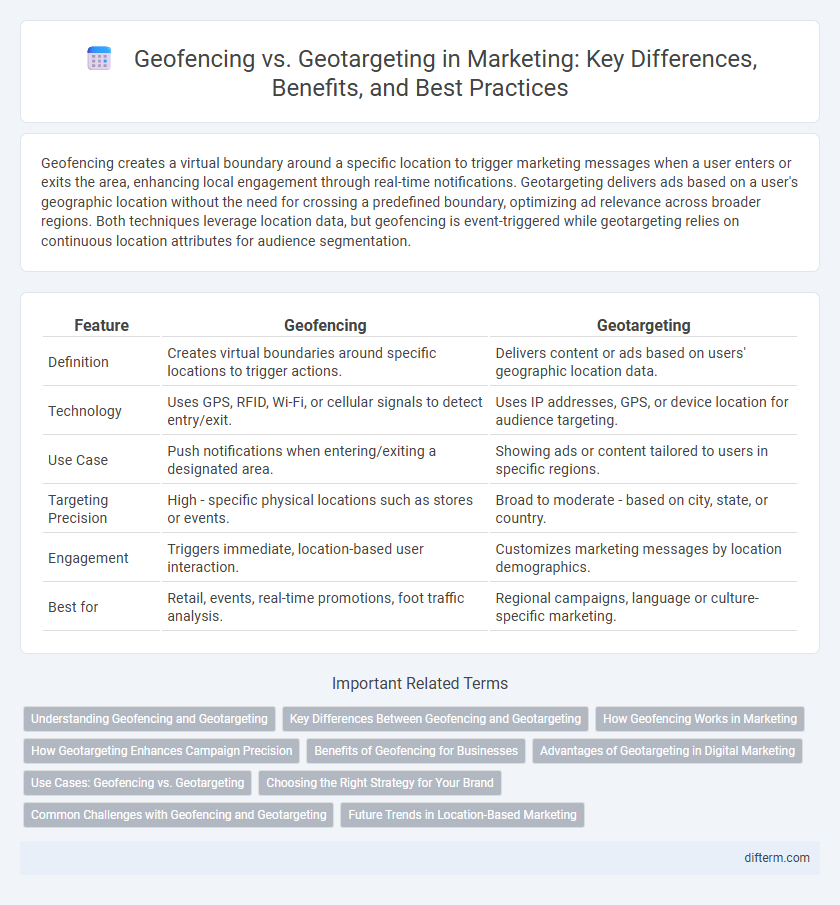Geofencing creates a virtual boundary around a specific location to trigger marketing messages when a user enters or exits the area, enhancing local engagement through real-time notifications. Geotargeting delivers ads based on a user's geographic location without the need for crossing a predefined boundary, optimizing ad relevance across broader regions. Both techniques leverage location data, but geofencing is event-triggered while geotargeting relies on continuous location attributes for audience segmentation.
Table of Comparison
| Feature | Geofencing | Geotargeting |
|---|---|---|
| Definition | Creates virtual boundaries around specific locations to trigger actions. | Delivers content or ads based on users' geographic location data. |
| Technology | Uses GPS, RFID, Wi-Fi, or cellular signals to detect entry/exit. | Uses IP addresses, GPS, or device location for audience targeting. |
| Use Case | Push notifications when entering/exiting a designated area. | Showing ads or content tailored to users in specific regions. |
| Targeting Precision | High - specific physical locations such as stores or events. | Broad to moderate - based on city, state, or country. |
| Engagement | Triggers immediate, location-based user interaction. | Customizes marketing messages by location demographics. |
| Best for | Retail, events, real-time promotions, foot traffic analysis. | Regional campaigns, language or culture-specific marketing. |
Understanding Geofencing and Geotargeting
Geofencing creates virtual boundaries around specific locations using GPS or RFID technology, enabling marketers to trigger targeted messages when users enter or exit these zones. Geotargeting, on the other hand, delivers personalized content based on broader user location data such as city, region, or country. Both strategies enhance local marketing by increasing relevance and engagement through location-based audience segmentation.
Key Differences Between Geofencing and Geotargeting
Geofencing creates virtual boundaries around specific geographic areas to trigger location-based marketing actions when consumers enter or exit these zones, while geotargeting delivers ads or content based on a user's current location without predefined boundaries. Geofencing focuses on real-time proximity engagement using GPS or RFID technology, whereas geotargeting leverages IP addresses or device data to tailor campaigns for broader or neighborhood-scale targeting. The key difference lies in geofencing's dynamic, event-driven approach compared to geotargeting's static, location-specific content delivery strategy.
How Geofencing Works in Marketing
Geofencing in marketing operates by setting virtual boundaries around specific geographic locations using GPS or RFID technology, triggering targeted messages or advertisements when a consumer enters or exits the predefined zone. This location-based strategy enables brands to deliver highly relevant promotions and real-time offers, increasing customer engagement and conversion rates. Marketers utilize geofencing to enhance local campaigns, optimize foot traffic, and gather actionable data on consumer behavior within designated areas.
How Geotargeting Enhances Campaign Precision
Geotargeting enhances campaign precision by delivering tailored content and advertisements to specific audiences based on their exact locations, such as neighborhoods or zip codes. This method utilizes IP addresses, GPS data, and mobile signals to refine audience segmentation, increasing engagement and conversion rates. By concentrating marketing efforts on narrowly defined geographic areas, businesses can optimize ad spend and improve return on investment more effectively than broader geofencing approaches.
Benefits of Geofencing for Businesses
Geofencing offers businesses precise location-based targeting by creating virtual boundaries around specific areas, enabling personalized and timely marketing messages to consumers within those zones. This technology enhances customer engagement and increases conversion rates by delivering highly relevant promotions at the right moment. Companies leveraging geofencing benefit from improved brand awareness, optimized ad spend, and valuable insights into consumer behavior patterns within targeted locations.
Advantages of Geotargeting in Digital Marketing
Geotargeting offers precise audience segmentation based on location data, enabling marketers to deliver personalized content and promotions that drive higher engagement and conversion rates. It allows businesses to optimize ad spend by targeting only relevant users, improving ROI while minimizing wasted impressions. Enhanced analytics from geotargeted campaigns provide actionable insights into customer behavior and preferences within specific regions, supporting data-driven marketing strategies.
Use Cases: Geofencing vs. Geotargeting
Geofencing is ideal for hyper-local campaigns that trigger notifications or offers when customers enter a specific radius, such as retail store promotions or event-based marketing. Geotargeting excels in delivering tailored content based on broader location parameters like city or region, making it effective for regional advertising or demographic-specific campaigns. Both strategies enhance customer engagement by leveraging location data, but geofencing focuses on immediate physical presence while geotargeting targets users within defined geographic areas.
Choosing the Right Strategy for Your Brand
Geofencing creates a virtual boundary around a specific location to trigger marketing messages when users enter or leave that area, while geotargeting delivers ads based on a user's geographic location without requiring entry into a defined zone. Brands aiming for highly localized, event-specific campaigns benefit from geofencing's precise, real-time engagement, whereas businesses seeking broader audience reach across regions may find geotargeting more effective due to its scalable location-based targeting. Evaluating campaign goals, budget constraints, and desired customer interaction depth ensures selection of the optimal strategy to maximize ROI and brand visibility.
Common Challenges with Geofencing and Geotargeting
Common challenges with geofencing and geotargeting include inaccurate location data due to GPS limitations and device signal variability, resulting in reduced targeting precision. Both strategies face privacy concerns and regulatory restrictions, such as GDPR and CCPA, which limit data collection and user tracking capabilities. Furthermore, high implementation costs and integration complexities with existing marketing platforms can hinder campaign scalability and effectiveness.
Future Trends in Location-Based Marketing
Future trends in location-based marketing emphasize the integration of AI-driven geofencing and real-time geotargeting to enhance precision and customer engagement. Predictive analytics will allow marketers to anticipate consumer behavior and deliver hyper-personalized promotions based on location data. The growth of 5G technology will boost the effectiveness of both techniques by enabling faster data processing and more dynamic targeting strategies.
Geofencing vs Geotargeting Infographic

 difterm.com
difterm.com